Intro
Ejector pumps are essential devices frequently utilized in residential and commercial settings. They serve a unique function in managing wastewater, particularly in scenarios where gravity drainage is ineffective. The objective of this article is to present a detailed exploration into the workings of ejector pumps. We will discuss their mechanisms, various components, and specific applications, allowing readers to understand their importance better. This structured guide will be especially useful for housewives and homeowners, highlighting the DIY aspects and practical applications of ejector pumps in everyday life.
Materials:
To successfully understand and possibly engage in installing or maintaining ejector pumps, acquiring the right materials is crucial. Here’s a list of the essential materials you will need:
- Ejector Pump: 1 unit, capacity should be based on household needs
- PVC Pipes: 2-inch diameter; lengths will vary based on installation
- Check Valve: 1 unit, suitable for the pipe diameter
- Pipe Fittings: elbows, tees, and couplings, various sizes
- Wrench: Adjustable or pipe wrench
- PVC Cement: 1 container
- Teflon tape: 1 roll
- Electrical Wiring: Gauge as per pump specifications
- Float Switch: 1 unit, compatible with pump
- Screws and Anchors: As required for secure installation
- Bucket or Basin: Optional for collection during testing
DIY Steps:
Step-by-Step Process
-
Planning: Assess the specific needs of your wastewater system and determine the optimal pump size.
-
Assemble Tools and Materials: Gather all the items listed above before starting the installation.
-
Shut off Power: Safety must be a priority; ensure all electrical sources are turned off before work begins.
-
Prepare the Area: Clear the installation site of any debris or obstructions.
-
Install the Ejector Pump: Position the pump in the designated area, ensuring it can effectively collect fluid. Proper orientation is crucial.
-
Connect Pipes: Using PVC cement, attach the PVC pipes ensuring a tight and sealed fit. Apply Teflon tape to threaded sections to prevent leaks.
-
Attach the Float Switch: Ensure the float switch is operational and properly positioned so it activates the pump at the right levels.
-
Make Electrical Connections: Follow the manufacturer’s instructions strictly for wiring. Poor connections can lead to pump failure.
-
Test the System: Before finalizing the installation, fill the pump with water to check for leaks and ensure operation.
-
Secure Everything: Once testing is complete and you are satisfied, tidy up the area, securing any loose electrical wiring or components.
Technical Aspects:
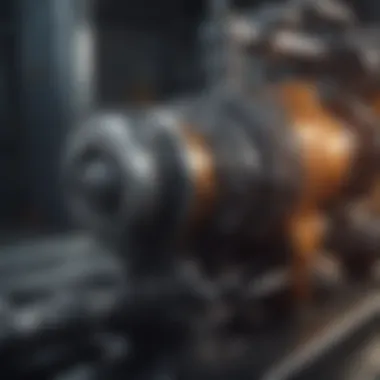
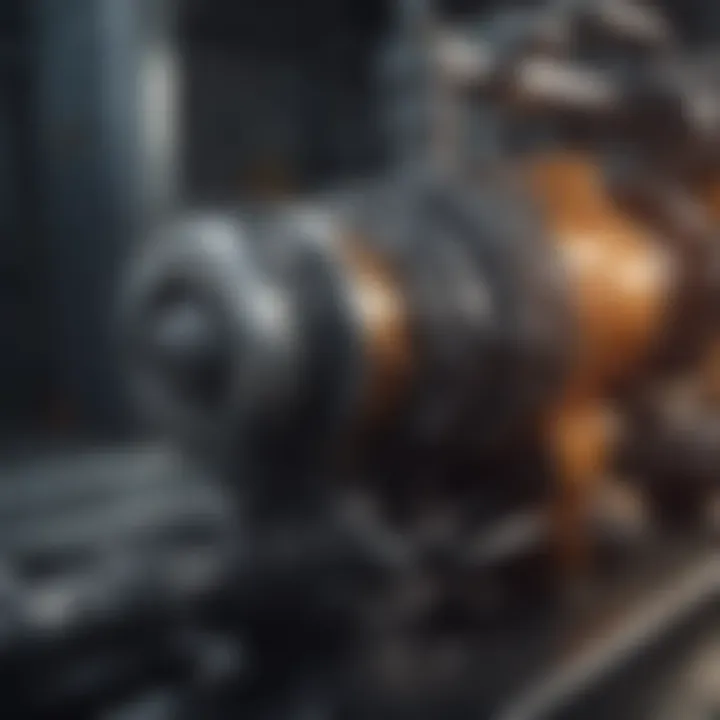
Tools Needed
- Voltage Tester: To ensure electrical safety.
- Wire Strippers: For preparing electrical connections.
- Drill: For making holes if needed for mounting.
Timing Specifics
- Installation can take approximately 2 to 4 hours, depending on your familiarity with the components.
- Testing should include a 20-minute operation check to ensure everything works seamlessly.
Troubleshooting Tips:

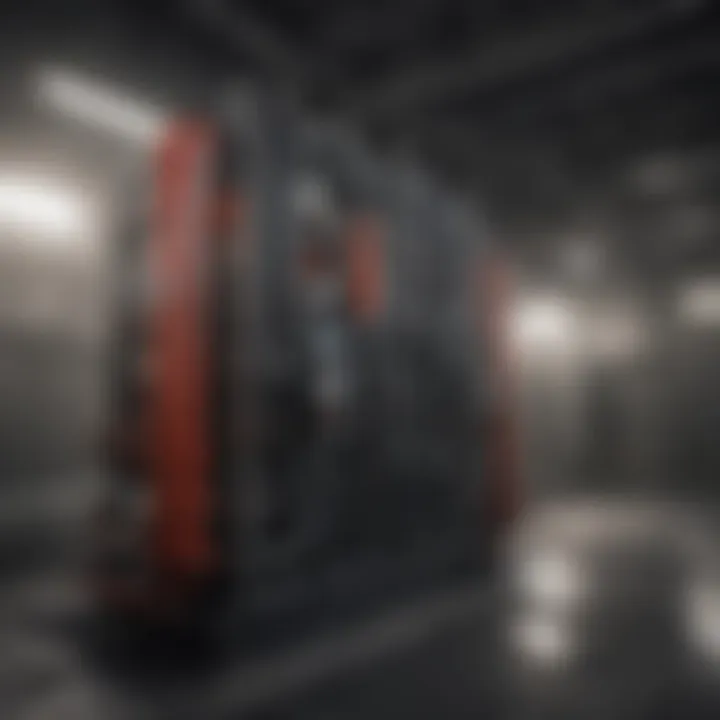
Sometimes issues arise during or after installation. Here are solutions for common problems:
- Pump Does Not Start: Check electrical connections for any loose wiring.
- Frequent Cycling: Adjust the float switch to ensure it triggers at appropriate fluid levels.
- Blockages: Regularly maintain and clean the ejector pump and its components to avoid debris buildup.
"Ejector pumps work effectively when correctly installed, ensuring a smooth operation for your home’s drainage needs."
This understanding of ejector pumps will not only guide homeowners in effective installation but also ensure they can maintain their systems effectively, ultimately enhancing waste management in their households.
Foreword to Ejector Pumps
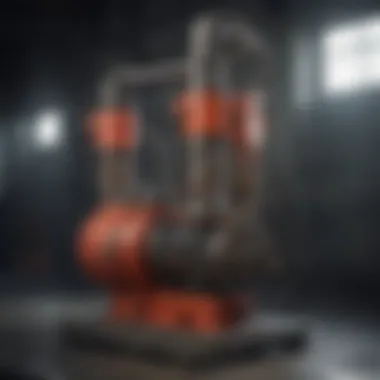
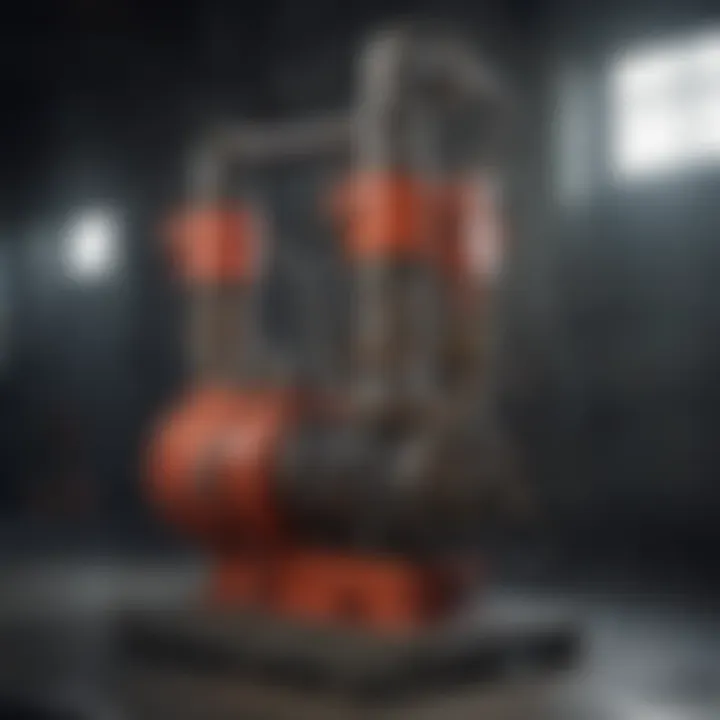
Ejector pumps play a crucial role in various sectors, providing an effective means for fluid transport in challenging environments. Understanding their functionality not only sheds light on their operational efficiency but also on their significance in ensuring optimal performance in specific applications. For homeowners and industry professionals alike, a solid grasp of ejector pumps is essential. They help in managing waste, facilitating processes, and maintaining sanitary conditions.
Definition and Purpose
Ejector pumps are devices designed to move fluids, typically in situations where traditional pumps cannot operate efficiently. They function based on the principle of jet propulsion, using high-velocity jets of fluid to create a vacuum that draws in additional fluids. Their primary purpose is to transport waste or other liquids from lower to higher elevations, enabling effective drainage and management of fluids, particularly in residential and industrial settings.
Key Applications in Industry
Ejector pumps are employed in a variety of applications, showcasing their versatility and importance in different sectors. The following are notable applications:
Wastewater treatment
Wastewater treatment is one of the most common applications of ejector pumps. These pumps effectively remove sewage and industrial waste, preventing contamination and promoting environmental sustainability. The key characteristic of ejector pumps in this context is their ability to handle solid waste particles, making them a beneficial choice. Unlike conventional pumps, ejector pumps require less maintenance and exhibit robust operation over long periods. Their unique design allows for efficient operation even in adverse conditions.
Chemical processing
In the chemical processing industry, ejector pumps are utilized for moving a variety of fluids, including corrosive substances. Their key characteristic here is adaptability to different chemical properties, which can vary widely across different processes. This adaptability ensures safety and efficiency during operations. However, it is critical to select materials that resist corrosion to avoid potential hazards such as leaks and equipment failure, which underscores the importance of careful material selection when using ejector pumps in chemical applications.
Food and beverage processing
Ejector pumps also find usage in food and beverage processing, where hygiene and safety are paramount. Their key characteristic is the ability to transport liquids without introducing contaminants. They are commonly used for moving fluids like juices or sauces where maintaining product integrity is essential. This application highlights their unique feature of being less prone to spoilage or contamination compared to other pump types. Nevertheless, regular maintenance is necessary to ensure that food safety standards are met.
In summary, ejector pumps offer various applications across industries due to their effectiveness and robustness. Understanding these key aspects will help users make informed decisions when considering ejector pumps for specific applications.
Principles of Operation
Understanding the principles of operation for ejector pumps is essential for comprehending their functionality. Ejector pumps utilize the concepts of fluid dynamics to achieve efficient liquid movement. The principles guide the design and application of these pumps in various settings, ensuring desired performance and reliability. Knowledge of such principles helps users make informed decisions about Ejector pumps, optimizing their use in different scenarios.
Basic Mechanism of Ejector Pumps
Fluid entrainment
Fluid entrainment is a key mechanism in the operaion of ejector pumps. This process involves the movement of a primary fluid that draws in secondary fluid. The main characteristic of fluid entrainment is its ability to create a vacuum effect, facilitating the transfer of liquids. This is especially beneficial in scenarios like wastewater management where quick evacuation is necessary.
The unique feature of fluid entrainment lies in its capacity to move larger volumes of fluid with minimal effort. It's simple and does not require complex machinery, which makes it both cost-effective and energy efficient. However, one disadvantage can be the dependency on initial fluid pressure, which may limit its effectiveness in scenarios with low driving pressure.
Jet propulsion
Jet propulsion is another fundamental mechanism employed in ejector pumps. This method uses high-speed jets of fluid to create a significant pressure drop, furthering the movement of liquids. A notable characteristic of jet propulsion is its dynamic action, which leads to rapid fluid motion and effective mixing of different fluids. Jet propulsion also proves to be a popular choice for many applications due to its effectiveness in moving fluids across varying distances.
The unique feature of jet propulsion is its versatility across a range of industrial applications. It can handle different types of liquids, from clear water to more viscous slurries. Nevertheless, one disadvantage to consider is the energy consumption. Higher energy inputs are needed to create the jet, which can impact operational costs.
The Role of Venturi Effect
The Venturi effect plays a crucial role in the operation of ejector pumps. This phenomenon occurs when fluid flows through a constricted section of pipe, leading to a reduction in pressure. This reduction creates the necessary conditions for fluid to be drawn into the pump system. Understanding the Venturi effect is fundamental because it enhances the efficiency of ejector pumps, allowing them to operate effectively even in less than ideal conditions.
In summary, a clear understanding of these principles will greatly benefit anyone looking to make informed decisions regarding ejector pumps. The effectiveness and efficiency tied to proper application of fluid dynamics principles ensures successful fluid management across various industries.
Components of Ejector Pumps
In the context of ejector pumps, understanding the components is crucial. Each part plays a significant role in ensuring optimal functionality and efficiency. Recognizing how these components connect and contribute helps users make informed decisions regarding maintenance and upgrades. Ejector pumps rely on precision engineering, and each component must work seamlessly with the others to achieve the desired results. This section will systematically review the primary components and material considerations, exploring their features and benefits.
Primary Component Overview
Nozzle
The nozzle serves as the entry point for the pressurized fluid in an ejector pump. It creates a high-speed jet of fluid, initiating the fluid entrainment process. One key characteristic of the nozzle is its design, often tapered to enhance velocity. This design is a popular choice due to its efficiency in converting pressure energy into kinetic energy. A beneficial aspect of the nozzle design is its ability to minimize energy losses, providing better overall performance. However, one disadvantage could be the potential for wear over time due to the high fluid velocity.
Diffuser
The diffuser is an equally critical component following the nozzle in the ejector pump assembly. It works by converting the high-speed flow from the nozzle to a pressure build-up. The unique feature of the diffuser lies in its ability to slow down the fluid while increasing its pressure, requiring careful design for optimal efficiency. This characteristic makes the diffuser a beneficial option, especially in applications where high pressure is essential. However, low-quality diffusers may suffer from cavitation, which can lead to decreased performance.
Motor
The motor is the powerhouse of the ejector pump, driving the system and sustaining its operation. A key aspect of the motor is its capacity to provide consistent torque and speed, crucial for ensuring that the pump can handle varying workloads effectively. Motors are generally reliable, and their robustness makes them a popular choice in various applications. One unique feature of certain motor types, such as submersible motors, is their ability to function efficiently underwater. Nevertheless, the drawback can be potential overheating if not monitored or maintained correctly.
Material Considerations
Selecting appropriate materials is vital for maximizing the lifespan and efficiency of ejector pumps. The materials impact durability, resistance to environmental factors, and overall performance. This section will discuss casing materials and seal types, highlighting their importance in maintaining function and safety.
Casing materials
Casing materials affect the strength and lifespan of an ejector pump. Common materials include stainless steel and thermoplastics. Stainless steel, known for its corrosion resistance, is beneficial in harsh environments, extending the pump's operational life. One key characteristic is its ability to withstand high pressure. On the downside, stainless steel can be more expensive than other options. Thermoplastics are lighter and often cost-effective but may lack the strength needed in high-pressure scenarios, leading to potential failure.
Seal types
Seals play an essential role in preventing leaks and ensuring efficiency within the system. There are various types of seals available, such as mechanical seals and elastomeric seals. Mechanical seals are notable for their effectiveness in high-pressure environments, providing robust leak protection. They require careful installation, which can be a drawback. Elastomeric seals, on the other hand, are more flexible and easier to install, making them a popular choice. However, they may not perform as well under extreme pressure or temperature conditions.
Understanding the components and materials of ejector pumps is essential for ensuring functionality and longevity.
Types of Ejector Pumps
In this section, we will explore the various types of ejector pumps and their relevance to the understanding of ejector pump functionality. Recognizing the differences and advantages of each type can greatly aid homeowners and industry professionals in selecting the right solution for their specific needs. Each type comes with unique characteristics, benefits, and limitations that should be carefully considered.
Single-Stage vs Multi-Stage Pumps
Single-stage ejector pumps operate with one stage of pressure increase, making them simpler in design. These pumps are effective for applications requiring lower lift but can handle varying flow rates efficiently. A key advantage of single-stage pumps is their ease of installation and maintenance, making them a popular choice for residential use.
On the other hand, multi-stage ejector pumps consist of multiple impellers, which allows for a greater pressure increase. This capability makes them suitable for applications needing higher lift, like some industrial environments. However, the complexity of these pumps means more maintenance is often required. They are valuable for situations where intense lifting is necessary but come with higher operational costs due to their intricate components.
Application-specific Designs
Submersible ejector pumps
Submersible ejector pumps are designed to operate underwater, making them ideal for applications in shallow wells or sewage setups. Their construction allows them to be located beneath the fluid surface while efficiently moving liquids to the desired location. A key characteristic of submersible pumps is that they reduce the amount of suction lift required, which enhances their reliability and performance.
The submersible design provides a significant advantage in space-constrained environments. They avoid the need for extensive above-ground apparatus, simplifying the setup process. However, they may require more robust maintenance due to their submerged components exposed to potential corrosion.
Air ejectors
Air ejectors operate by using air as the motive fluid, creating a suction effect to move liquids from one location to another. One valuable attribute of air ejectors is their versatility. They can handle a variety of liquids and solids without worrying about the specific characteristics of the fluid being pumped. This makes them beneficial in diverse applications, from wastewater treatment to chemical processing.
Their unique feature is the ability to provide a non-mechanical pumping method, reducing wear and tear on components. The downside is that air ejectors can be less effective in terms of efficiency compared to other types under certain operating conditions, such as high viscosity fluids. Understanding these pros and cons is crucial for homeowners and operators making informed decisions about which ejector pump to use.
Fluid Dynamics in Ejector Pumps
Fluid dynamics plays a critical role in the operation of ejector pumps. It is the study of how fluids behave in motion, and it directly influences the efficiency and effectiveness of these pumps. Understanding fluid dynamics allows us to optimize the design and operation of ejector pumps, leading to better performance and reliability in various applications.
Understanding Flow Rate and Pressure
Flow rate is the volume of fluid that passes through a specific point in a given time period. In ejector pumps, maintaining an appropriate flow rate is essential. This rate affects the pump’s capability to move liquids. Pressure, meanwhile, is the force exerted by the fluid, influencing how well the pump can perform under different conditions. Together, flow rate and pressure determine the overall efficiency of the system. An imbalance can lead to decreased pump functionality, such as cavitation or reduced output.
Factors Affecting Efficiency
Viscosity
Viscosity defines a fluid's resistance to flow. In the context of ejector pumps, viscosity affects how easily the pump can move the fluid through its system. Liquids such as oils typically have higher viscosity compared to water. This means they are thicker and require more energy to pump. A significant characteristic of viscosity is that it changes with temperature, making it a variable that needs consideration in pump design.
High-viscosity fluids may slow down the flow rate, leading to inefficiencies. When designing ejector pumps, engineers must account for the typical viscosity of the fluid being pumped. Choosing the appropriate viscosity level is crucial for ensuring optimal performance.
Temperature
Temperature is another important factor that influences fluid dynamics in ejector pumps. Higher temperatures typically lower the viscosity of a fluid, making it easier to pump. Conversely, lower temperatures increase viscosity, which can create challenges. The unique feature of temperature is its direct impact on energy consumption. If a fluid is too viscous, more energy is required to pump it, raising operational costs.
Maintaining an appropriate temperature is vital for maximizing efficiency. Understanding how temperature plays a role in fluid behavior helps in creating effective operational protocols and pump designs.
In summary, both viscosity and temperature are fundamental in understanding the performance of ejector pumps, influencing flow rates and energy use.
The overall efficiency of ejector pumps depends on effective management of these factors. By optimizing viscosity and monitoring temperature, operators can ensure better performance and reduce the chances of equipment failure.
Installation and Setup
The installation and setup of ejector pumps is a crucial phase that directly impacts their performance and longevity. It’s not merely about placing the pumps in position, but rather involves meticulous planning and execution of tasks that can mitigate risks and enhance efficiency. Focusing on precise site selection and proper electrical and water line connections contributes to the reliability of the system.
Site Selection and Preparation
Choosing the right site for the installation of an ejector pump cannot be overstated. It is not just about finding a place, but requires careful consideration of the terrain, accessibility, and proximity to existing water lines. The objective is to ensure optimal performance while minimizing potential future problems.
Key factors to consider include:
- Topography: The slope of the land affects drainage. A downward slope can aid in gravity-fed systems.
- Accessibility: Ensure that the area is easily reachable for maintenance and service.
- Distance from Electrical Sources: Keeping the pump close to the electrical supply can reduce installation complexity.
- Environmental Concerns: Be mindful of local regulations and environmental impacts.
Once the site is selected, preparation is next. This involves clearing any debris, checking soil stability, and ensuring that drainage paths are free from blockage. Adequate groundwork will allow for secure anchoring of the pump and prevent settling issues after installation.
Connecting Electrical and Water Lines
Properly connecting electrical and water lines is fundamental in ensuring the ejector pump operates with maximum efficiency. Each connection must meet specific standards to avoid failures that can lead to serious disruptions.
Steps for effective connection:
- Electrical Connection: Ensure that the pump is connected to a dedicated circuit to prevent overloading. Always use a qualified electrician for this task to comply with local safety codes.
- Check that power supply meets pump specifications.
- Install a circuit breaker to protect the pump.
- Water Line Connection: The connection must be tight and leak-proof. Use appropriate fittings and sealants to guarantee a secure installation.
- Follow manufacturer's guidelines for any specific requirements.
- Ensure that the line is sloped properly to facilitate smooth water flow.
Making these connections correctly has substantial benefits. It reduces the likelihood of future leaks, ensures consistent performance, and enhances the overall safety of the system.
Complete and careful preparation during the installation phase can significantly reduce maintenance costs and increase the lifespan of ejector pumps.
Through thoughtful attention to site selection and careful connection practices, owners can ensure their ejector pumps deliver reliable performance well into the future.
Maintenance Considerations
Maintenance of ejector pumps is crucial for ensuring their longevity, efficiency, and safety. Regular upkeep can effectively prevent breakdowns, ensuring systems operate smoothly. In this section, we will look into scheduled maintenance protocols and common issues that can arise if proper care is not taken.
Scheduled Maintenance Protocols
Implementing a rigorous scheduled maintenance protocol is beneficial for ejector pumps. This not only keeps them functioning optimally but also mitigates the risk of unexpected failures. A typical maintenance routine may include the following:
- Regular inspections: Each pump should be inspected at defined intervals. This helps in identifying wear and tear or irregularities in operation.
- Cleaning: Remove debris and any blockages that can hinder performance. Clean the filters and check the suction areas, as buildup can lead to mechanical failures.
- Lubrication: Regular lubrication of moving parts ensures smoother operation. It prevents excessive friction, which may lead to overheating.
- Checking electrical connections: Ensure that all electrical components, such as switches and connections, are secure and functioning properly. Broken connections may result in operational failures.
- Monitoring performance: Keeping records of operational metrics over time can highlight changes in performance, indicating the need for maintenance or part replacement.
Having a schedule not only helps in organization but also creates a culture of precaution in maintaining these vital systems.
Common Issues and Troubleshooting
Despite routine care, ejector pumps may face issues. Identifying and understanding these problems can aid in efficient troubleshooting and resolution. Below are two common issues faced by ejector pumps:
Clogging
Clogging is a prevalent issue that can dramatically affect performance. Waste buildup, small particles, and foreign objects can obstruct the flow path. This leads to increased pressure and reduced efficiency. The key characteristic of clogging is that it can occur at unexpected times, often leading to system failure if not addressed.
:> It’s vital to regularly check for signs of clogging to avoid costly downtimes and repairs.
Benefits of understanding clogging include:
- Early detection leading to reduced repair costs.
- Minimized operational disruptions through proactive cleaning schedules.
However, relying solely on the practice of clearing clogs can be a disadvantage. It may lead to repeated failures if the root causes are not addressed, such as unsuitable materials being processed.
Leakage
Leakage is another significant concern that can affect overall functionality. Leakages often result from worn-out seals or damaged parts, allowing fluid to escape from the system. This not only wastes resources but can also create hazards in the surrounding areas.
The key aspect of leakage is its potential to escalate into more serious issues, if not attended promptly. It can lead to flooding or contamination of other areas.
The advantages of addressing leakage include:
- Improved safety by preventing environmental contamination.
- Efficient resource management by reducing waste.
On the downside, leakage repairs can be costly and may require specific expertise depending on the type of fluid involved. Understanding leaks helps in implementing better preventive measures and maintaining the integrity of the ejector pump system.
By addressing these common issues diligently, house owners can ensure a reliable and efficient ejector pump system.
Ending
The conclusion serves as a pivotal element in this discussion of ejector pumps, encapsulating the essential insights gathered throughout the article. Ejector pumps are not merely mechanical devices but vital components in numerous industries. They facilitate efficient fluid transfer, addressing diverse needs from wastewater management to food processing. Understanding their functionality enhances decision-making for homeowners and industry professionals alike.
Summary of Key Takeaways
-
Ejector pumps rely on the principles of fluid dynamics for fluid movement, utilizing the Venturi effect for efficient operation.
-
These pumps are suitable for various applications, including wastewater treatment, thus ensuring proper sanitation and environmental protection.
-
Regular maintenance is crucial to prevent issues such as clogging and leakage, ensuring long-lasting performance.
-
When considering an ejector pump, careful attention should be given to site selection, fluid characteristics, and specific application needs.
Future Trends in Ejector Pump Technology
As technology progresses, ejector pumps are also evolving. Some of the potential future trends include:
-
Increased Automation: Advanced sensors and control systems may allow for real-time monitoring, improving efficiency and reducing maintenance.
-
Energy Efficiency: New designs and materials may lead to pumps that operate with less energy, reflecting growing concerns regarding sustainability.
-
Smart Technology Integration: The incorporation of Internet of Things (IoT) technology can facilitate better remote management and diagnostics.
-
Enhanced Materials: Development of more durable materials could improve resistance to corrosive fluids, thereby extending pump service life.
Understanding these aspects is crucial for selecting the right equipment and ensuring effective operation in various settings.





